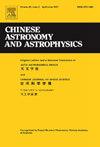Advance in the Research of Stellar Superflares
Q4 Physics and Astronomy
引用次数: 0
Abstract
The Solar flare is one of the most violent eruptive phenomena in the Solar system, which releases energy up to J in tens of minutes. With the development of observational techniques, similar flare events have been observed on stars, with typical energy of 10 to times that of Solar flares, which is known as the superflare. Studies of stellar superflares and their mechanisms are not only important for understanding the internal structure, evolution, and magnetic activities of stars, but also for exploring the habitability and extraterrestrial life on exoplanets. A brief introduction is first given on Solar flares and the associated phenomena of magnetic activities, stellar magnetic field, and superflares of stars. Then, current detection methods and research results of stellar superflares are reviewed in terms of selection, energy evaluation, starspots, and the statistical relationships between the flare parameters and stellar parameters. Meanwhile, a comparison is made with the theories of Solar flares and the related physical processes to explore their similarities and connections. Finally, a summary is made and the related further work is also discussed.
恒星超级耀斑研究进展
太阳耀斑是太阳系中最剧烈的爆发现象之一,它在数十分钟内释放出高达 1025 焦耳的能量。随着观测技术的发展,在恒星上也观测到了类似的耀斑事件,其典型能量是太阳耀斑的 10 到 104 倍,这就是所谓的超级耀斑。对恒星超级耀斑及其机制的研究不仅对了解恒星的内部结构、演化和磁活动非常重要,而且对探索系外行星的宜居性和系外生命也非常重要。本文首先简要介绍了太阳耀斑及其相关的磁活动现象、恒星磁场和恒星超级耀斑。然后,从耀斑的选择、能量评估、星斑以及耀斑参数与恒星参数之间的统计关系等方面回顾了目前恒星超级耀斑的探测方法和研究成果。同时,将其与太阳耀斑理论及相关物理过程进行比较,探讨两者的相似性和联系。最后,进行了总结并讨论了相关的进一步工作。
本文章由计算机程序翻译,如有差异,请以英文原文为准。
求助全文
约1分钟内获得全文
求助全文
来源期刊

Chinese Astronomy and Astrophysics
Physics and Astronomy-Astronomy and Astrophysics
CiteScore
0.70
自引率
0.00%
发文量
20
期刊介绍:
The vigorous growth of astronomical and astrophysical science in China led to an increase in papers on astrophysics which Acta Astronomica Sinica could no longer absorb. Translations of papers from two new journals the Chinese Journal of Space Science and Acta Astrophysica Sinica are added to the translation of Acta Astronomica Sinica to form the new journal Chinese Astronomy and Astrophysics. Chinese Astronomy and Astrophysics brings English translations of notable articles to astronomers and astrophysicists outside China.
 求助内容:
求助内容: 应助结果提醒方式:
应助结果提醒方式:


